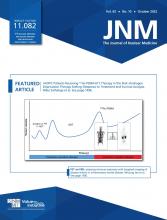Then He said to Thomas, “Put your finger here; see my hands. Reach out your hand and put it into my side. Stop doubting and believe.”
—John 20:27
A recent commentary from Sartor et al. in The Journal of Nuclear Medicine (1) questions the use of prostate-specific membrane antigen (PSMA) PET imaging for selection criteria for PSMA-targeted therapy, commenting on the newly published outcome of patients with PSMA PET/CT screen failure by VISION trial criteria (2). In addition, comments by Hussain et al. in Journal of Clinical Oncology (3) regarding the role of PSMA PET in patients with metastatic hormone-sensitive prostate cancer have added to the controversy. Both commentaries require a response, with our main points of concern below.
PERSONALIZED MEDICINE
Targeted therapy intends to selectively hit tumor cells expressing the specific target. In contrast to many novel targeted therapies that rely on a single tissue sample, PSMA PET, which serves as a companion diagnostic for PSMA radioligand therapy, displays in vivo the presence of PSMA expression in all detected tumor lesions. The likelihood to benefit from PSMA radioligand therapy is clearly higher in patients with more PSMA-avid metastases (4). Although careful investigation of the benefit of PSMA radioligand therapy in PSMA PET–negative patients indeed warrants further formal testing, questioning the predictive value of PSMA PET in metastatic hormone-sensitive prostate cancer ridicules the concept of precision oncology.
MISGUIDED CONCLUSIONS
Many worthy points are made, including an emphasis on patient quality of life and that medicine is an art in which management decisions integrate physical examination, laboratory, imaging, and other data with clinical judgment. We also wholeheartedly agree with the statement that management discussions should be had with an interdisciplinary group, often including the image-interpreting physician (3). However, this does not tally with the conclusion of Hussain et al. (3) that, “Outside clinical trials, our shared recommendation is that there is little utility currently for the routine use of PSMA-PET in patients with detectable metastases on [conventional imaging] and recommendations regarding therapy should be based on [conventional imaging] findings.” We do not see how this conclusion was drawn, nor do we see the methodology Hussain et al. used to build this recommendation after citing a work demonstrating that PSMA PET imaging is more sensitive than conventional imaging (5), with fewer false-positive and equivocal findings at a lower radiation dose, which are the relevant measures for a diagnostic test. Additionally, PSMA PET has a per-node specificity of 99% (6) and has been convincingly shown to lead to major patient management changes in the hands of experienced genitourinary oncologists (7–10). Furthermore, PSMA PET is predictive of freedom from progression in men undergoing salvage radiation therapy for biochemical recurrence after radical prostatectomy (11). Given these advantages and regulatory approval, it seems bizarre to use less accurate tests to guide therapy decisions. This is akin to managing lung cancers using chest radiographs instead of CT.
FEAR OF OVERDIAGNOSIS
One of the arguments made was that with a more sensitive imaging modality, more micrometastases will be found, leading to upstaging and overtreatment, with possible declines in quality of life and no proven survival benefit (3). We agree that longer-term studies evaluating survival differences with PSMA PET compared with conventional imaging are needed but are not without challenges (12). However, one must consider that a higher specificity leads to fewer harms caused by the false-positive results of conventional imaging. In the ProPSMA study sensitivity analysis, when equivocal imaging findings were considered positive, the false-positive rate of conventional imaging was an alarming 23% (9). Curiously, the authors then go on to contradict their first point of avoiding upstaging, by adding that despite the higher sensitivity of PSMA PET, micrometastases could be missed (false-negatives) and that curative adjuvant therapy should not be withheld on the basis of negative PET results (3). The claim, therefore, is that PSMA PET is both too sensitive and not sensitive enough.
STAGE MIGRATION
Hussain et al. (3) state that replacing conventional imaging with PSMA PET/CT is likely to cause stage migration. However, we believe that stage migration should be distinguished from the study biases it may produce (13). Stage migration is a consequence of the introduction of any new (and usually better) classification technique due to higher sensitivity. This is counterbalanced by improved specificity, with the overall impact being unknown, requiring further study. The authors do not make this distinction or note that biases potentially caused by stage migration need to be considered in trial designs, instead suggesting that the Will Rogers effect is a reason against replacing conventional imaging with new techniques (3).
CONCLUSION
For diagnosis of high-risk prostate cancer, localization of biochemical recurrence, and PSMA treatment selection, the most accurate diagnostic method should be used—PSMA PET/CT. This principle is accepted by multiple international guidelines. The opportunity to study both the benefits and the detriments of PSMA PET use remains open.
DISCLOSURE
Michael S. Hofman acknowledges philanthropic/government grant support from the Prostate Cancer Foundation (PCF) funded by CANICA Oslo Norway, Peter MacCallum Foundation, Medical Research Future Fund, NHMRC Investigator Grant, Movember, U.S. Department of Defense and the Prostate Cancer Foundation of Australia (PCFA). No other potential conflict of interest relevant to this article was reported.
ACKNOWLEDGMENTS
Ken Herrmann, Anwar R. Padhani, Michael S. Hofman, and Stefano Fanti are members of the Advanced Prostate Cancer Consensus Conference 2022 Imaging Expert Group, Lugano, Switzerland.
Footnotes
Published online Jun. 9, 2022.
- © 2022 by the Society of Nuclear Medicine and Molecular Imaging.
REFERENCES
- Received for publication May 10, 2022.
- Accepted for publication June 2, 2022.







